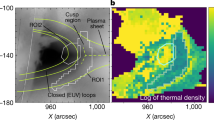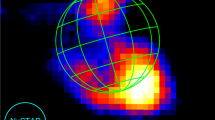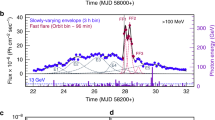Abstract
Two very intense and impulsive nuclear γ-ray and electron bremsstrahlung X-ray emitting solar flares, on 7 and 21 June 1980, were observed with <2 s time resolution. These observations have allowed us to study, for the first time, the relative starting times of energetic ion and electron interactions with the solar atmosphere. The simultaneous starting times of X rays >40 keV and γ-ray emission show that electrons and ions were accelerated within seconds of each other. The near simultaneous peaking, together with the observation of >400-MeV neutrons, show that the solar flare acceleration process can produce the full intensity and spectrum of electrons (>1 MeV) and ions (>102 MeV) in a time scale of <5 s. These results are in direct contradiction to the widely accepted concept of solar flare particle acceleration.
This is a preview of subscription content, access via your institution
Access options
Subscribe to this journal
Receive 51 print issues and online access
$199.00 per year
only $3.90 per issue
Buy this article
- Purchase on Springer Link
- Instant access to full article PDF
Prices may be subject to local taxes which are calculated during checkout
Similar content being viewed by others
References
Brown, J. C. & Smith, D. F. Rep. Prog. Phys. 43, 125–197 (1980).
Ramaty et al. in Solar Flares (ed. Sturrock, P.) 117–181 (Colorado Associated University Press, 1980).
Forrest, D. J. et al. Solar Phys. 65, 15–23 (1980).
Chupp, E. L. et al. Astrophys. J. Lett. 244, L171–L174 (1981).
Reppin, C. et al. Bull. Am. astr. Soc. 12, 891 (1981).
Share, G. H. et al. Bull. Am. astr. Soc. 12, 891 (1981).
Forrest, D. J. et al. Bull. Am. astr. Soc. 12, 890 (1981).
Chupp, E. L. et al. Astrophys. J. Lett. 235, L95–L99 (1982).
Forrest, D. J. et al. 17th int. Cosmic. Ray Conf. 10, 5–8 (1981).
Frost, K. J. & Dennis, B. R. Astrophys. J. 165, 655–659 (1971).
Bai, T. & Ramaty, R. Sol. Phys. 49, 343–348 (1976).
Bai, T. & Ramaty, R. Astrophys. J. 227, 1072–1077 (1979).
Emslie, A. G. Astrophys. J. 271, 367–375 (1983).
Nakajima, H. et al. Nature 305, 292–294 (1983).
Kaufmann, P., Costa, J. E. R. & Strauss, F. M. Solar Phys. 81, 159–165 (1982).
Hudson, H. S. Solar Phys. 57, 237–240 (1978).
Von Rosenvinge, T. T. et al. 17th int. Cosmic Ray Conf. 3, 28–35 (1981).
Pesses, M. E. et al. 17th int. Cosmic Ray Conf. 3, 36–39 (1981).
Author information
Authors and Affiliations
Rights and permissions
About this article
Cite this article
Forrest, D., Chupp, E. Simultaneous acceleration of electrons and ions in solar flares. Nature 305, 291–292 (1983). https://doi.org/10.1038/305291a0
Received:
Accepted:
Issue Date:
DOI: https://doi.org/10.1038/305291a0
This article is cited by
-
Extreme solar events
Living Reviews in Solar Physics (2022)
-
Overview of the Volume
Space Science Reviews (2011)
-
Solar Sources of Heliospheric Energetic Electron Events—Shocks or Flares?
Space Science Reviews (2007)
Comments
By submitting a comment you agree to abide by our Terms and Community Guidelines. If you find something abusive or that does not comply with our terms or guidelines please flag it as inappropriate.



